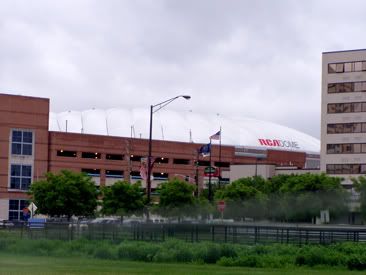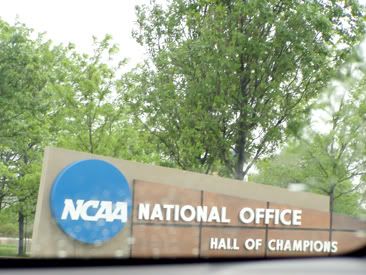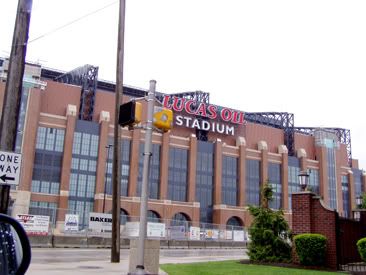
The sports aspect of our visit to Indianapolis started in a confusing way, as my wife and I puzzled over the news vans at Indy’s Methodist Hospital, until I realized that the victim of Danica Patrick’s “pit hit” was recuperating there. The whole city (not just Methodist) was abuzz with Indy 500 fever, as we were there the day after the qualifying heats and less than two short weeks before the big race. There were checkered flags everywhere, especially as we headed west out of the city towards the speedway. As in Talladega, I was blown away by the sheer size of it. Given that there are only a handful of events taking place there (in its nearly hundred year history, only around 230 races have occurred at the Brickyard), its dimensions are insane to me. With permanent seating space for over 250,000, and infield seating for 150,000 more, it’s the highest capacity sports facility in world history. And, peering through the chain link fence around it, it looks it, too—this image from the Speedway’s website serves to further make the point.
The Brickyard (which is technically located in its own city, entirely contained within Indianapolis, called Speedway, Indiana) is also the site of the Indianapolis Motor Speedway Hall of Fame, a nice companion to the NCAA Hall of Champions, which is also in Indy. The Hall of Champions (which was closed for renovations when we were there) is adjacent to the NCAA Headquarters, where I considered leading a one-man protest on behalf of the CSULB men’s basketball team, before deciding to visit the Colts old and new stadiums instead.
I’d been to the RCA Dome before, so there weren’t any surprises there (although we were hoping deconstruction would have begun—which it hadn’t—so we could sneak in and grab some rubble). The new home of the Colts (and newly announced site of the 2012 Super Bowl), though, Lucas Oil Stadium, was quite a surprise. It’s incredibly tall, taller than it looks in photos, and has a design and character to its exterior that most indoor fields don’t. Partly, I imagine this is due to the fact that the stadium will also serve as a basketball arena whenever Indy plays host to the Final Four and other NCAA Tourney games.
The stadium cost, by some estimates, may be close to $750 mil, with 650 of that coming from the city, which wants a world-class stadium for its Colts and other local teams, including collegiate and playoff high school competition. It’s a large cost, no doubt, but one that most major cities consider necessary. It’s also not money wasted: hosting a Super Bowl (and of course, any NFL team that builds a new stadium almost automatically gets to) is generally thought to bring in between 300 and 400 million dollars alone—Detroit brought in an estimated $370 million two years ago. Add on top of this the money to be made from other tournaments, concerts, and events that can be brought in, as well as the boost to local restaurants and bars (probably negligible in Indy since they already had a stadium), and its easy to see why most major cities see world class stadiums as a profitable investment. I’m still hoping that Long Beach will eventually see the light. If we were in the middle of the Midwest, instead of living in the shadow of L.A., there’s almost no doubt that we would have by now.




